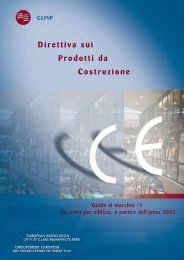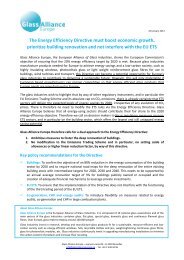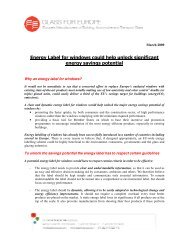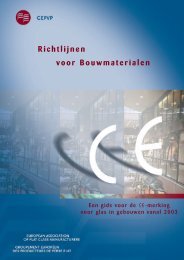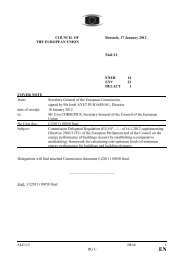GEPVP CPD 4 (EN12150-2).EN.indd - Glass for Europe
GEPVP CPD 4 (EN12150-2).EN.indd - Glass for Europe
GEPVP CPD 4 (EN12150-2).EN.indd - Glass for Europe
- No tags were found...
Create successful ePaper yourself
Turn your PDF publications into a flip-book with our unique Google optimized e-Paper software.
ConstructionProductsDirectiveEvaluation of con<strong>for</strong>mity of “Thermallytoughened soda lime silicate safety glass” to hE N 12150-2(July 2005)G E P V P , T H E E U R O P E A N A S S O C I AT I O N O F F L AT G L A S S M A N U FA C T U R E R Sm e m b e r s : G L AV E R B E L , G U A R D I A N , P I L K I N G T O N , S A I N T- G O B A I N G L A S S
Construction Products Directive
Evaluation of con<strong>for</strong>mity of“Thermally toughened soda lime silicate safety glass” to hE N 12150-2CONT<strong>EN</strong>TSA. Background ........................................................................................................................4B. Audience ...........................................................................................................................4C. Scope ...............................................................................................................................43D. Methodology ......................................................................................................................4Annex ZA ..........................................................................................................................4Attachment 1: h<strong>EN</strong> Clause 4 Requirements .............................................................................10Attachment 2: h<strong>EN</strong> Clause 5 Evaluation of con<strong>for</strong>mity ..............................................................15Attachment 3: h<strong>EN</strong> Clause 6 Marking and labelling ..................................................................16Attachment 4: h<strong>EN</strong> Annex A Factory production control ............................................................17Attachment 5: h<strong>EN</strong> (Annex B) Provisions <strong>for</strong> voluntary involvement of third party(ies) ...................17Attachment 6: h<strong>EN</strong> Annex ZA .................................................................................................17Attachment 7: h<strong>EN</strong> Other Annex(s) ........................................................................................18
Construction Products DirectiveABACKGROUNDThe first document prepared by the <strong>GEPVP</strong> explained the background to compliance with the <strong>CPD</strong> 1 and thesecond explained the principles of evaluation of con<strong>for</strong>mity 2 .This document will explain the system of ‘Evaluation of Con<strong>for</strong>mity’ applicable <strong>for</strong> “thermally toughened soda limesilicate safety glass” as laid down in <strong>EN</strong> 12150-2 3 , the appropriate harmonised <strong>Europe</strong>an Standard (h<strong>EN</strong>).BAUDI<strong>EN</strong>CEThis part is applicable to any manufacturer of thermally toughened soda lime silicate safety glass.CSCOPEThis is taken from <strong>EN</strong> 12150-2.“This <strong>Europe</strong>an Standard covers the evaluation of con<strong>for</strong>mity and the factory production control of thermallytoughened soda lime silicate safety glass <strong>for</strong> use in buildings.”D METHODOLOGY (see also summary figure 1)4This document follows the methodology given in the second document. It also follows the same referencing withrespect to “attachments”, etc.This document includes explanatory in<strong>for</strong>mation on Clause ZA.2.2 – EC Certificate and Declaration of Con<strong>for</strong>mity(see Attachment 6).Annex ZAAs detailed in the second document the starting point <strong>for</strong> undertaking the evaluation of con<strong>for</strong>mity is Table ZA.1(below). This table is colour coded and each essential characteristic is numbered to line up with the correspondingtable in the second document.The “Systems of Attestation of Con<strong>for</strong>mity” <strong>for</strong> the claimed intended uses are given in Table ZA.2 of the h<strong>EN</strong>.Details of the tasks relating to ‘Assignment of Evaluation of Con<strong>for</strong>mity’ are given in Tables ZA.3.1 to ZA.3.3 ofthe h<strong>EN</strong> (see second document <strong>for</strong> explanation).The relationship between the intended use, the applicable “Systems of Attestation of Con<strong>for</strong>mity” and the roles ofthe manufacturer and Notified Body(ies) is given in Figure 2. This figure is specific to con<strong>for</strong>mity with <strong>EN</strong> 12150-2.When a manufacturer has finalised the collection of all applicable in<strong>for</strong>mation then he can proceed to CE Marking.This is detailed in Clause ZA.2.2 (see Attachment 6). Based on the manufacturer’s declaration of con<strong>for</strong>mity is theCE Marking label. Examples of CE Marking labels <strong>for</strong> different thermally toughened soda lime silicate safety glassproducts with different intended uses/characteristics and hence “Systems of Attestation of Con<strong>for</strong>mity” are shownin Figures 3 and 4.1<strong>GEPVP</strong> CONSTRUCTION PRODUCTS DIRECTIVE – A guide to CE marking <strong>for</strong> glass in building 2003 onwards2<strong>GEPVP</strong> CONSTRUCTION PRODUCTS DIRECTIVE – Evaluation of con<strong>for</strong>mity as laid down in the harmonised <strong>Europe</strong>anStandards (h<strong>EN</strong>s)3<strong>EN</strong> 12150-2 <strong>Glass</strong> in building – Thermally toughened soda lime silicate safety glass – Part 2: Evaluation of con<strong>for</strong>mity/Product standard
Evaluation of con<strong>for</strong>mity of“Thermally toughened soda lime silicate safety glass” to hE N 12150-2Figure 1 – Summary of methodologyAnnex ZAPurchase h<strong>EN</strong>Table ZA.11 st columnTable ZA.12 nd columnDetermine particularrequirementsDefine Intended Use‘essential characteristics’1 to 13See Clause 4Carry out required actionsTable ZA.2Clause ZA.2.2Determine System ofAttestation of Con<strong>for</strong>mity<strong>for</strong> each intended useDetermine assignmentof tasks <strong>for</strong> each systemof attestationLevel 1 Level 3 Level 4Table ZA.3.14 th columnTable ZA.3.24 th columnTable ZA.3.34 th columnCollect all in<strong>for</strong>mation – Proceed to CE MarkingPrepare Certificateof Con<strong>for</strong>mityLevel 1 onlyPrepare Declarationof Con<strong>for</strong>mityClause ZA.2.35Determine evaluationof con<strong>for</strong>mity clausesCE Marking+AccompanyingIn<strong>for</strong>mationSee Clause 5andAnnex A
Construction Products DirectiveTable ZA1 – Specific to <strong>EN</strong> 12150 – 2: Thermally toughened soda lime silicate safety glassProduct: Thermally toughened soda lime silicate safety glass as covered under the scope ofthis standardIntended use: In buildings and construction worksRef. Essential CharacteristicsRequirements in thisand other <strong>Europe</strong>anStandard(s)Mandatedlevelsand/orclassesNotesSafety in the case of fire –(1)Resistance to fire (<strong>for</strong> glass <strong>for</strong> use in a glazedassembly intended specifically <strong>for</strong> fire resistance)4.2, 4.3.1 and 4.3.2.1AllMinutes(2)(3)Reaction to fireExternal fire per<strong>for</strong>mance (<strong>for</strong> roof coverings only)4.2, 4.3.1 and 4.3.2.24.2, 4.3.1 and 4.3.2.3AnyAnyEuroclassesEuroclassesSafety in Use –6(4)(5)Bullet resistance: Shatter properties andresistance to attackExplosion resistance: Impact behaviour andresistance to attack4.2, 4.3.1 and 4.3.2.44.2, 4.3.1 and 4.3.2.5--Classes ofconvenienceClasses ofconvenience(6)Burglar resistance: Shatter properties andresistance to attack4.2, 4.3.1 and 4.3.2.6-Classes ofconvenience(7)Pendulum body impact resistance: Shatterproperties (safe breakability) and resistance toimpact4.2, 4.3.1 and 4.3.2.7-Classes ofconvenience(8)Mechanical resistance: Resistance againstsudden temperature changes and temperaturedifferentials4.2, 4.3.1 and 4.3.2.8-K and/or °C(9)Mechanical resistance: Resistance against wind,snow, permanent and imposed load and/orimposed loads of the glass unit4.2, 4.3.1 and 4.3.2.9-mm(10) Protection against noise –Direct airborne sound reduction4.2, 4.3.1 and 4.3.2.10 - dBEnergy conservation and heat retention –(11)Thermal properties4.2, 4.3.1 and 4.3.2.11-W/(m².K)(12)Radiation properties:- light transmittance and reflectance4.2, 4.3.1 and 4.3.2.12-Fractions or %(13)- solar energy characteristics4.2, 4.3.1 and 4.3.2.13-Fractions or %
Evaluation of con<strong>for</strong>mity of“Thermally toughened soda lime silicate safety glass” to hE N 12150-2Figure 2 – Relationship between Intended Use, System of Attestation of Con<strong>for</strong>mityand the Roles of Manufacturer and Notified Body – Specific to <strong>EN</strong> 12150-2Ref.Intended UseApplicable Systemof Attestation ofCon<strong>for</strong>mityInitial Type Testing(ITT)Producer/ManufacturerNotified TestingBodyProducer/ManufacturerFactory Production Control (FPC)Notified Certification BodyInspectionof FPCDocumentationInitial Inspectionof FactoryContinuousSurveillanceof FPC(1) Fire Resistance(4) Bullet Resistance1 NA X X X X X(5) ExplosionResistance(3) External FirePer<strong>for</strong>mance(6),(7),(8),(9)Safety in Use(10) Noise Reduction3 NA X X NA NA NA7(11),(12),(13)EnergyConservation(2) Reaction to Fire 4 X NA X NA NA NAKey: NA not applicableXbody responsible
Construction Products DirectiveFigure 3 – Example of a CE Marking label <strong>for</strong> System of Attestation of Con<strong>for</strong>mity 101234 1AnyCo Ltd, PO Box 21, B-10500501234-<strong>CPD</strong>-00234 26mm Thermally toughened (FR) glass<strong>EN</strong> 12150-2Thermally toughened soda lime silicate safety glass(fire resistant), intended to be used in buildings andconstruction works8CharacteristicsResistance to fire E30 3Reaction to fire A1*External fire per<strong>for</strong>manceBullet resistanceExplosion resistanceBurglar resistancePendulum body impact resistanceResistance against sudden temperaturechanges and temperature differentialsWind, snow, permanent and imposedload resistanceDirect airborne sound insulationThermal propertiesNPDNPDNPDNPD1(C)1200K6mm31(-2;-3)dB5,6W/(m 2 .K)Radiation properties:Light transmittance and reflectance 0,85/0,11Solar energy characteristics 0,83/0,131Identification number of the certification body2Certificate number3Reference to the certification report. Traceable from the certification report will be detail(s) of the “virtual kit(s)”used <strong>for</strong> the fire testing.
Evaluation of con<strong>for</strong>mity of“Thermally toughened soda lime silicate safety glass” to hE N 12150-2Figure 4 – Example of a CE Marking label <strong>for</strong> System of Attestation of Con<strong>for</strong>mity 3AnyCo Ltd, PO Box 21, B-1050056mm Thermally toughened glass<strong>EN</strong> 12150-2Thermally toughened soda lime silicate safety glass, intendedto be used in buildings and construction worksCharacteristicsResistance to fireNPDReaction to fire A1*External fire per<strong>for</strong>manceBullet resistanceExplosion resistanceBurglar resistancePendulum body impact resistanceResistance against sudden temperaturechanges and temperature differentialsWind, snow, permanent and imposedload resistanceDirect airborne sound insulationThermal propertiesNPDNPDNPDNPD1(C)2200K6mm31(-2;-3)dB5,6W/(m 2 .K)9Radiation properties:Light transmittance and reflectance 0,85/0,11Solar energy characteristics 0,83/0,13
Construction Products DirectiveAttachment 1: h<strong>EN</strong> Clause 4 RequirementsClause No. Content Explanation4.1 Product description10For con<strong>for</strong>mity purposes the thermallytoughened soda lime silicate glassmanufacturer is responsible <strong>for</strong> thepreparation and maintenance of the productdescription. This description shall describe theproduct and/or product families.Disclosure of the product description shall beat the discretion of the thermally toughenedglass manufacturer or his agent except in thecase of regulatory requirements.The description shall contain at least anormative part. The description may alsocontain an in<strong>for</strong>mative part, when themanufacturer <strong>for</strong>esees further development ofthe product.The normative part of the description shallcontain the following minimum in<strong>for</strong>mation:- a reference to <strong>EN</strong> 12150 Parts 1 and 2and all other standards with which themanufacturer claims compliance.- the radiometric properties and durabilityof coated glass, i.e. coated glass thatcon<strong>for</strong>ms with <strong>EN</strong> 1096-1, <strong>EN</strong> 1096-2,<strong>EN</strong> 1096-3, when those properties arechanged, intentionally or unintentionally,by the thermal toughening process.The definition of product families shall beconsistent with the normative part of theproduct description.The substitution of materials shall maintainthe con<strong>for</strong>mity with the product description.The substituting material can be added tothe product family and also the productdescription when compliance has beendemonstrated.4.2 Con<strong>for</strong>mity with the definition of thermallytoughened soda lime silicate safety glassProducts shall con<strong>for</strong>m to the definition andfulfil the requirements of thermally toughenedsoda lime silicate safety glass as defined in<strong>EN</strong> 12150-1.4.3 Determination of the characteristic’sper<strong>for</strong>mances4.3.1 Characteristics of thermally toughenedsoda lime silicate safety glassThis document details the manufacturer’sproduct offering. It could contain, as far as theproduct is concerned, the following:1. Full range of glass types and thicknessesoffered;2. Details of edgework, holes, etc. whereapplicable;3. Full production control data;a. Pre-processing;b. Processing, heating/cooling/time.4. Full product control data:a. What tests;b. What pass level;c. If proxy testing: relationship to prescribedparameter.5. Special conditions <strong>for</strong> products, such as fireresistant toughened glass, which requiredifferent systems of attestation of con<strong>for</strong>mity;6. If coated glasses are toughened whatprocedures are used to show that the quotedfigures are applicable.Product families can be:1. Ones that have a claimed characteristicacross a range, e.g. <strong>EN</strong> 12600 per<strong>for</strong>mance<strong>for</strong> all toughened patterned glassesdetermined on the poorest per<strong>for</strong>mer;2. Ones that have identical processingconditions, e.g. clear glass and tinted glass ofthe same thickness, patterned glasses of thesame thickness.<strong>EN</strong> 12150-1 defines thermally toughened sodalime silicate safety glass products in Clause 3and their fracture characteristics in Clause 5.Also given is:fragmentation test in Clause 8, thermaldurability in Clause 9.3 and mechanical strengthin Clause 9.4.
Evaluation of con<strong>for</strong>mity of“Thermally toughened soda lime silicate safety glass” to hE N 12150-24.3.1.1 GeneralThe characteristics of thermally toughenedsoda lime silicate safety glass are in generalthose of the glass substrate (see 4.3.1.2).4.3.1.2 Characteristics of the soda lime silicateglass panes used <strong>for</strong> the production ofthermally toughened soda lime silicatesafety glassCharacteristics, generally, those of the incomingraw material, i.e. basic soda lime silicate glassproduct or coated soda lime silicate glassproduct.Panes shall be made of soda lime silicateglass according to <strong>EN</strong> 572-1, <strong>EN</strong> 572-2,<strong>EN</strong> 572-4, <strong>EN</strong> 572-5. The panes may becoated according to <strong>EN</strong> 1096–1, <strong>EN</strong> 1096-2,<strong>EN</strong> 1096-3 and/or enamelled according to<strong>EN</strong> 12150-1.For the characteristics listed in table 1, <strong>for</strong>the soda lime silicate glass panes, generallyaccepted values or calculated values may beused.Since the majority of the characteristicsof table 1 are not changed significantly bythe thermal toughening process they shallbe used <strong>for</strong> thermally toughened soda limesilicate safety glass. The exceptions shall bethe characteristic bending strength (ƒg,k) andthe resistance against sudden temperaturechanges and temperature differentials.The values given <strong>for</strong> resistance against suddentemperature change and characteristic bendingstrength (f g,k), see 4.3.2.8 and 4.3.2.9, areguaranteed by compliance with this standard.11Table 1: In<strong>for</strong>mation on thecharacteristics of soda lime silicate glasspanes, according to <strong>EN</strong> 572-1, used <strong>for</strong>the production of thermally toughenedsoda lime silicate safety glassIf some coatings, i.e. coated glass con<strong>for</strong>mingwith the <strong>EN</strong> 1096 series, when thermallytoughened change their radiometric propertiesthe manufacturer shall refer to the following<strong>for</strong> the determination of the appropriatecharacteristics, etc.:• 4.3.2.11 <strong>for</strong> the emissivity;• 4.3.2.12 <strong>for</strong> the light transmittance andreflectance;• 4.3.2.13 <strong>for</strong> the solar energytransmittance;• <strong>EN</strong> 1096-2 <strong>for</strong> the durability of A, B andS coatings;• <strong>EN</strong> 1096-3 <strong>for</strong> the durability of C andD coatings.If such changes occur then it is the responsibilityof the thermally toughened glass manufacturerto determine the values to be quoted.However, the coated glass supplier may beable to give values <strong>for</strong> the toughened producttogether with appropriate factory productioncontrol tests. There<strong>for</strong>e the toughener can quoteapplicable values as well as ensuring that theproduct values are maintained without the needto undertake these determinations.
Construction Products Directive4.3.2 Determination of characteristics ofthermally toughened soda lime silicatesafety glass products12If the thermally toughened glass manufacturerwishes to claim that any per<strong>for</strong>mancecharacteristic is independent of theproduction equipment used then the factoryproduction control system shall be inaccordance with this standard including hisspecific process control conditions.4.3.2.1 Safety in the case of fire – Resistanceto fire (1)Fire resistance shall be determined andclassified in accordance with <strong>EN</strong> 13501-2.4.3.2.2 Safety in the case of fire – Reaction tofire (2)Reaction to fire shall be determined andclassified in accordance with <strong>EN</strong> 13501-1.4.3.2.3 Safety in the case of fire – External firebehaviour (3)Where the manufacturer wishes to declareexternal fire per<strong>for</strong>mance (e.g. when subjectto regulatory requirements), the product shallbe tested and classified in accordance withpr<strong>EN</strong> 13501-5.Note: Compliance with this requirement is notpossible until a version of pr<strong>EN</strong> 13501-5later than 2002 becomes available.4.3.2.4 Safety in use – Bullet resistance: Shatterproperties and resistance to attack (4)Bullet resistance shall be determined andclassified in accordance with <strong>EN</strong> 1063.4.3.2.5 Safety in use – Explosion resistance:Impact behaviour and resistance toimpact (5)Explosion resistance shall be determined andclassified in accordance with <strong>EN</strong> 13541<strong>Glass</strong> CANNOT be tested <strong>for</strong> resistance to fireon its own. The tests have to be undertaken in aglazed assembly.The glazed assembly being regarded as a “virtualkit” 1 and is detailed in the official classificationreport.Thermally toughened soda lime silicate safetyglass products are products/materials that donot require to be tested <strong>for</strong> reaction to fire (e.g.Products/materials of Classes A1* according toCommission Decision 96/603/EC, as amended2000/605/EC).The present situation is that there are fourdifferent test methods in <strong>EN</strong>V 1187. Theapplicability of these tests to glass is not totallyclear. However, be<strong>for</strong>e deciding to test it isparamount that the manufacturer checks if thisparticular glass product type is permitted, bynational regulations, in this application.Thermally toughened soda lime silicate safetyglass would not be expected to pass this testmethod.NPD is the appropriate in<strong>for</strong>mation <strong>for</strong> theCE Marking label/accompanying in<strong>for</strong>mation.Thermally toughened soda lime silicate safetyglass would not be expected to pass this testmethod.NPD is the appropriate in<strong>for</strong>mation <strong>for</strong> theCE Marking label/accompanying in<strong>for</strong>mation.1Sectorial Group 09 – <strong>Glass</strong> in building: Testing protocol – Safety in case of fire – Fire resistance applicable <strong>for</strong> theCE Marking of glass <strong>for</strong> building.
Evaluation of con<strong>for</strong>mity of“Thermally toughened soda lime silicate safety glass” to hE N 12150-24.3.2.6 Safety in use – Burglar resistance:Shatter properties and resistance toattack (6)Burglar resistance shall be determined andclassified in accordance with <strong>EN</strong> 356.4.3.2.7 Safety in use – Pendulum body impactresistance: Shatter properties (safebreakability) and resistance to impact (7)Pendulum body impact resistance shall bedetermined and classified in accordance with<strong>EN</strong> 12600.4.3.2.8 Safety in use – Mechanical resistance:Resistance against sudden temperaturechanges and temperature differentials (8)The resistance against sudden temperaturechanges and temperature differentials isa generally accepted value that is givenin <strong>EN</strong> 12150-1 and shall be ensured bycompliance with this standard.4.3.2.9 Safety in use – Mechanical resistance:Resistance against wind, snow,permanent load and/or imposed loads ofthe glass unit (9)The mechanical strength of thermallytoughened soda lime silicate safety glassis a characteristic value that is given in<strong>EN</strong> 12150-1 and is ensured by compliancewith this standard.As long as on the concerned constructionor building site no part of pr<strong>EN</strong> 13474is applicable then the current method ofdetermining mechanical resistance in thecountry of destination shall be applied.The manufactured or supplied thickness ofthermally toughened soda lime silicate safetyglass shall con<strong>for</strong>m to the ordered thickness.Thermally toughened soda lime silicate safetyglass would not be expected to pass this testmethod.NPD is the appropriate in<strong>for</strong>mation <strong>for</strong> theCE Marking label/accompanying in<strong>for</strong>mation.If a manufacturer wants to make a per<strong>for</strong>manceclaim then the thermally toughened sodalime silicate safety glass shall be tested to<strong>EN</strong> 12600.Classification should be 1(C)Φ, where Φ isdependent upon product thickness/type.<strong>EN</strong> 12150-1: Clause 9.3 gives a generallyaccepted value of 200 K.<strong>EN</strong> 12150-1 gives values <strong>for</strong> the mechanicalstrength of thermally toughened soda limesilicate safety glass as follows:Float: clear )tinted ) -- 120N/mm 2coated )Enamelled float -- 75N/mm 2(based on enamelled surface in tension)Patterned glass andSheet glass -- 90N/mm 2Note: The characteristic bending strength has tobe used in conjunction with the design methodgiven in pr<strong>EN</strong> 13474 1Supplying what was ordered, in terms ofthickness, will cover this characteristic.131pr<strong>EN</strong> 13474: This standard is being drafted. It will consist of the following three parts:- determination by calculation of the resistance to load of glass used in fenestration;- determination by calculation of the resistance to load of glass used in common non-structural applications otherthan fenestration;- general basis of design.
Construction Products Directive4.3.2.10 Protection against noise – Direct airbornesound reduction (10)The sound reduction indexes shall bedetermined in accordance with <strong>EN</strong> 12758.However, the in<strong>for</strong>mation supplied with theincoming glass may be used as the thermaltoughening process does not alter the values.<strong>EN</strong> 12758 gives generally accepted valuesthat can be used in the absence of measureddata. Hence there is no reason to test thischaracteristic.144.3.2.11 Energy conservation and heat retention– Thermal properties (11)The thermal transmittance value (U-value)shall be determined by calculation inaccordance with <strong>EN</strong> 673 with:- emissivity ε : the declared value of theglass manufacturer. If the in<strong>for</strong>mation is notavailable, the emissivity shall be determinedin accordance with <strong>EN</strong> 12898.- nominal thickness of the glass panes4.3.2.12 Energy conservation and heat retention –Radiation properties: Light transmittanceand reflectance (12)The light transmittance and reflectance shallbe determined in accordance with <strong>EN</strong> 410.4.3.2.13 Energy conservation and heat retention– Radiation properties: Solar energycharacteristics (13)The solar energy transmittance andreflectance shall be determined in accordancewith <strong>EN</strong> 410.The in<strong>for</strong>mation supplied with the incomingmaterial can be used if the thermal tougheningprocess does not alter the values.If the thermal toughening process alters theemissivity then the value must be determined inaccordance with <strong>EN</strong> 12898. The determinationshould be obtained on a thermally toughenedsample.The in<strong>for</strong>mation supplied with the incomingmaterial can be used if the thermal tougheningprocess does not alter the values.The in<strong>for</strong>mation supplied with the incomingmaterial can be used if the thermal tougheningprocess does not alter the values.
Evaluation of con<strong>for</strong>mity of“Thermally toughened soda lime silicate safety glass” to hE N 12150-2Attachment 2: h<strong>EN</strong> Clause 5 Evaluation of con<strong>for</strong>mity5.2.2 Initial type testing of thermally toughenedsoda lime silicate safety glass5.2.2.1 GeneralTo establish if a product con<strong>for</strong>ms to thedefinition of thermally toughened soda limesilicate safety glass, initial type testing shallconsist of:a) mechanical strength measurement inaccordance with <strong>EN</strong> 12150-1;b) fragmentation test in accordance with<strong>EN</strong> 12150-1.Mechanical strength shall meet the requirementin <strong>EN</strong> 12150-1 Clause 9.4 when determined inaccordance with Annex B.1.1 of <strong>EN</strong> 12150-2.The fragmentation test is detailed in<strong>EN</strong> 12150-1 Clause 8.5.2.2.2 Test specimensThe test specimens needed <strong>for</strong> the initialtype test shall be processed from float glassaccording to <strong>EN</strong> 572-1 and <strong>EN</strong> 572-2 inaccordance with this standard.The ‘simplest’ type of edge work specifiedin the manufacturer’s production controldocumentation shall be used. However, if anarrissed edge is used then all other types ofedge working are deemed to satisfy.The number of test specimens is as follows:a) For mechanical strength measurementthey are given in table 2a <strong>for</strong> floatglass, table 2b <strong>for</strong> coated float glassand table 2c <strong>for</strong> enamelled float glass.b) For fragmentation 5 test specimens perthickness are requiredInitial type testing is undertaken on float glass,both coated and uncoated if appropriate.The tables detail the number of test specimensrequired <strong>for</strong> the 4-point mechanical strengthtest.[If a larger range of thicknesses is produced,than the table covers, then the manufacturermay wish to consider 2 specimens perthickness. This will give proof that all thicknessesmeet the strength requirement.]For all products/thicknesses fragmentation testsmust be undertaken.155.2.2.3 Test resultsa) When the mechanical strength ismeasured, no measured value shallbe below that given in clause 9.4 of<strong>EN</strong> 12150-1. However, if one valuefalls below then the manufacturer shallensure that the results relate to a 5 %probability of breakage at the lowerlimit of the 95 % confidence interval.b) In the fragmentation test, no testspecimen shall exhibit a fragmentationassessment that does not meetclauses 8.5 and 8.7 of <strong>EN</strong> 12150-1.
Construction Products Directive5.2.2.4 Measurement of surface pre-stressThe manufacturer may also use surfacepre-stress measurement as a means ofproduct control. If this is done then all testspecimens shall be measured prior to testing.This will show the relationship betweensurface pre-stress and mechanical strength/fragmentation.Manufacturers with more than one productionline may per<strong>for</strong>m the initial type test onspecimens from one line. The outcome valueof surface pre-stress measurement may thenbe used as reference <strong>for</strong> the other productionlines and shall be confirmed by factoryproduction control (FPC). This may also beapplied to new production lines.Measurement of surface pre-stress can beundertaken as a means of product control,(see Table A.1-3.1.4.1), <strong>for</strong> thermally toughenedfloat glass.The test should be undertaken as detailed inAnnex B.1.2.5.2.2.5 Thermally toughened patterned glass16Initial type testing of thermally toughenedpatterned glass may not be undertaken asa result of the wide variety of patternedsurfaces of patterned glass in accordancewith <strong>EN</strong> 572-5.Compliance of thermally toughened patternedglass shall be ensured by the sampling duringproduct control given Annex A – Table A.1– 3.1.3 together with either 3.1.4.2 or3.1.4.3.If a manufacturer only toughens a small numberof pattern types/thicknesses then it may beworthwhile to subject test specimens to themechanical strength and fragmentation tests(see 5.2.2.1).However, a manufacturer can produce theseproducts as long as they ensure by the factoryproduction control, especially product control,that they meet the requirements.Attachment 3: h<strong>EN</strong> Clause 6 Marking and labelling6.2 Product markingThe thermally toughened soda lime silicatesafety glass product shall be marked inaccordance with Clause 10 of <strong>EN</strong> 12150-1.The manufacturer shall permanently mark with:- name or trade mark- <strong>EN</strong> 12150
Evaluation of con<strong>for</strong>mity of“Thermally toughened soda lime silicate safety glass” to hE N 12150-2Attachment 4: h<strong>EN</strong> Annex A Factory production controlAnnex ATables A1Factory production control requirementsThis is covered in the <strong>GEPVP</strong> seconddocument “Evaluation of con<strong>for</strong>mity”.Table A1 applies to all types of thermallytoughened soda lime silicate safety glass.These cover:- Incoming raw materials- Process control- Product controlAttachment 5: h<strong>EN</strong> Annex C – Provisions <strong>for</strong> voluntary involvement of third party(ies)See Attachment 5 in the second document. There is nothing specific to this h<strong>EN</strong>.Attachment 6: h<strong>EN</strong> Annex ZA17Clause ZA.2.2 EC Certificate and Declaration of Con<strong>for</strong>mityDepending upon the intended use of the product and hence the applicable “System of Attestation ofCon<strong>for</strong>mity” will be the extent to which this clause applies.1. Products with System of Attestation of Con<strong>for</strong>mity – 1;This System of Attestation of Con<strong>for</strong>mity requires the involvement of a Notified Certification Body(NCB). It is the responsibility of the NCB, when they are satisfied that compliance with the conditionsof the Annex ZA has been achieved, to produce a certificate of con<strong>for</strong>mity (EC Certificate ofCon<strong>for</strong>mity). This certificate allows the manufacturer to affix the CE Marking (see Figure 3). The detail ofwhat is to be included in the certificate is given in the h<strong>EN</strong>.When the manufacturer has the certificate of con<strong>for</strong>mity then a declaration of con<strong>for</strong>mity(EC Declaration of Con<strong>for</strong>mity) has to be produced. The detail of what is to be included in thedeclaration is given in the h<strong>EN</strong>.2. Products with System of Attestation of Con<strong>for</strong>mity – 3;This System of Attestation of Con<strong>for</strong>mity only requires the involvement of a Notified Body (NB) with theInitial Type Testing of the product. When the manufacturer is satisfied that compliance with this Annexhas been achieved then a declaration of con<strong>for</strong>mity (EC Declaration of Con<strong>for</strong>mity) is prepared. Thisdeclaration allows the manufacturer to affix the CE Marking (see Figure 4). The detail of what is to beincluded in the declaration is given in the h<strong>EN</strong>.
Construction Products Directive3. Products with System of Attestation of Con<strong>for</strong>mity – 4;This System of Attestation of Con<strong>for</strong>mity does not require the involvement of a Notified Body (NB).There<strong>for</strong>e when the manufacturer is satisfied that compliance with this Annex has been achieved thena declaration of con<strong>for</strong>mity (EC Declaration of Con<strong>for</strong>mity) is prepared. This declaration allows themanufacturer to affix the CE Marking. The detail of what is to be included in the declaration is given inthe h<strong>EN</strong>.Duplication of in<strong>for</strong>mation between the certificate, where applicable, and the declaration should beavoided. This can be done by cross-referencing between documents if one contains more in<strong>for</strong>mation thanthe other.EC Declaration of Con<strong>for</strong>mity and, if applicable, the EC Certificate of Con<strong>for</strong>mity shall be presented in theofficial language or languages of the Member State in which the product is to be used.Attachment 7: h<strong>EN</strong> Other Annex(s)Annex B (in<strong>for</strong>mative) - Tests <strong>for</strong> factory production control18Clause No. Content ExplanationB.1 Strength measurementB.1.1 Four point bending strength testB.1.1.1 RequirementsB.1.1.2B.1.1.3For the requirements, refer to the value given in<strong>EN</strong> 12150-1 when measured in accordance with<strong>EN</strong> 1288-3 1 .Measurement methodThis test should be per<strong>for</strong>med in accordance with<strong>EN</strong> 1288-3.Test specimensThe dimensions of the test specimens should bein accordance with <strong>EN</strong> 1288-3.The test specimens will be manufactured inaccordance with this standard.<strong>EN</strong> 12150-1 defines the mechanical strengthof thermally toughened soda lime silicatesafety glass products in Clause 9.4.<strong>EN</strong> 1288 – 3 Clause 7 details the testprocedure<strong>EN</strong> 1288 – 3 Clause 6.2 details the specimendimensions, i.e. 1100±5mm by 360±5mm.Test specimens must be manufactured inaccordance with the Factory ProductionControl – Annex A1<strong>EN</strong> 1288-3: <strong>Glass</strong> in building – Determination of the bending strength of glass – Part 3: Test with specimens supported attwo points (four point bending)
Evaluation of con<strong>for</strong>mity of“Thermally toughened soda lime silicate safety glass” to hE N 12150-2B.1.2Optical surface pre-stress measurementB.1.2.1If the optical surface pre-stress measurement isa part of the factory production control then thevalues obtain during factory production controlmay not be less than the reference valuesobtained during the initial type test (see 5.2.2).Additionally <strong>for</strong> these test specimens thefragmentation should be in accordance with therequirements of <strong>EN</strong> 12150-1.Measurement methodPre-stress measurements should con<strong>for</strong>m to therecommendation of the test equipment supplier.See specifically Clause 5.2.2.4See B.2.The pre-stress measurements should have placeon five points as indicated in figure B.1B.2 Fragmentation testB.2.1B.2.2RequirementsFor the requirements, refer to <strong>EN</strong> 12150-1.Test methodFragmentation tests should be per<strong>for</strong>med inaccordance with <strong>EN</strong> 12150-1.<strong>EN</strong> 12150-1 defines the fragmentation ofthermally toughened soda lime silicate safetyglass products in Clauses 8.5 and 8.7<strong>EN</strong> 12150-1 details the fragmentation test <strong>for</strong>thermally toughened soda lime silicate safetyglass products in Clauses 8.1 to 8.4.19Figure B.1100±10Dimensions in mm






